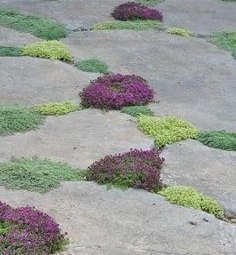Best plants for planting alongside pathways, filling gaps in garden paths, patios and cracks in concrete.
shade / herbaceous borders / clay // Winter colour / dry / sandy soil / chalky soil / slopes / bog gardens / ground cover / Low maintenance /

In this article I have listed the best plants to plant around and fill the various gaps in pathways, concrete and patios in a garden. I have listed them in categories that take foot traffic into account.
As with most garden flowers, shrubs and plants, sun and shade are important considerations too.
Plants for paths and pathways with light foot traffic, for areas with heavy foot traffic and plants for gaps in a patio are listed below.
- Plants suitable for planting in gaps in patios and pathways.
- Plants for paths and pathways with heavy foot traffic that are walked on regularly.
- Plants for cracks and crevices in paths and pathways with light foot traffic.
- Preparing the soil for planting plants in gaps.
Plants suitable for planting in gaps in patios and pathways.

A read for rainy days
In fairy tales, there is always a
Prince Charming and a bad man. Sometimes in real life, Prince Charming is the bad man, or the
bad man turns out to be Prince Charming.
Please be aware, this is not a fairy tale. This book contains references to grooming gangs, sexual abuse, Gaslighting, and punishment of the abusers. Also NON-WOKE scrutiny of British
society.
A dark story of gaslighting, sexual abuse, retribution, and hope. Based on the author's conversations with Willow, a young girl hidden from Society, and with Richard an ex-soldier now working for
a covert agency The Organisation. This book tells how Richard confronts those in authority blocking Willow from the therapy she needs to escape from them and recover, he’s aware of the
consequences. But having ignored evil too often, he’s ready for the risks.
CLICK LINK FOR FREE READ SAMPLE Kindle version Paperback
Planting plants in paths will brighten up the path with foliage colour and sometimes flowers and will also help suppress and keep weeds out. Best of all, some species like Thyme give of scent when crushed under foot.
As in the rest of your garden, select pathway plants for tolerance to full sun, shade and water and soil requirements, but above all else, foot traffic tolerance.
Plants for paths and pathways with heavy foot traffic that are walked on regularly.
is an unusual evergreen plant that will tolerate part shade and damper conditions and does not mind being walked on. It's a native of New Zealand so you may have to do a bit of searching for this plant. Its ideal for paths and ground cover, only growing to about 2 inches high and forming a creeping weed-proof mat with foliage resembling tiny, delicate fern fronds. It makes great ground cover, minimising weeding, as it forms a tight carpet of green.
It is a creeper so will need blocking from areas around the path, you might need to stop it spreading too.
Plants for cracks and crevices in paths and pathways with light foot traffic.
Pathway plants suitable for planting in areas with light foot traffic,
These pathway plants are great plants for planting alongside garden paths and between stepping-stones.
Aubrieta deltoidea, Dianthus deltoids, Erinus alpinus, Scabiosa graminifolia, and Thymus.
crevices:
Globularia cordifolia, Lewisia tweedyi, Saxifraga callosa, Sedum spathulifolium, Sempervivum, and Thymus.
Plants for planting in pockets:
America maritime, Campanula portenschlagiana, Cerastium tomentosum, Sedum telephium, and Veronica prostrate.
Preparing the soil for planting plants in gaps.
Whatever plants you are planting in cracks, concrete, gaps in paths, pathway edges or steps. The area will need to be prepared by removing weeds, digging out any hardcore used to build the base and breaking up the compacted topsoil. This can be done with a screwdriver or small scraper. If the soil is really poor you could add some compost from your heap or topsoil from another part of the garden.
If you are planting seeds, prepare the area in the normal way and keep the soil moist until they grow, then thin them out leaving only the strongest plants. Sowing seeds tips
hanging baskets / shade / herbaceous borders / clay / window boxes / pathways / Winter colour / dry / sandy soil / chalky soil / slopes / bog gardens / ground cover / Low maintenance / home
Writing your first book or novel? This new website provides advice and tips to help write, edit, publish, market and promote it https://www.faircop.com/
